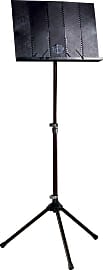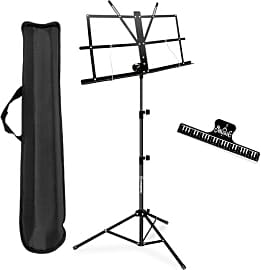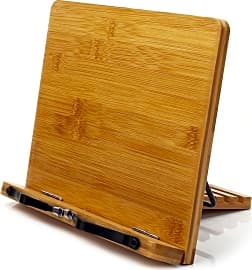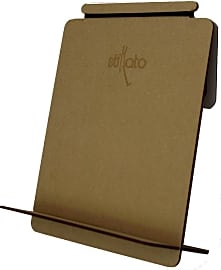The 10 Best Music Stands

This wiki has been updated 47 times since it was first published in March of 2015. Nothing beats the sound of live music, so if you're a performer of any type, we salute you. Whether you require one for school, home, busking, or the concert hall, you're certain to find just the right stand for your needs on this list. We've included models that will suit budgets of all sizes, in addition to folding, portable options with bags for traveling musicians. When users buy our independently chosen editorial choices, we may earn commissions to help fund the Wiki.
Editor's Notes
February 13, 2020:
Due to availability issues, we've removed the Coocheer Performance, Musician's Gear Deluxe Conductor, and Be Sharpe Music Adjustable at this time; we've opted to remove the Gearlux Vented, too, over concern about the durability of some of its parts. Those who want a vented model (which weigh less than solid versions) might consider the Maestro Metal. It is collapsible, easy enough to carry, and relatively inexpensive. For a standard version, we still like the Manhasset Orchestra, which comes from a top name. It is on the pricier end of the spectrum, but it's made to last and has a convenient double lip. Or, if you'd like a folding wire version, there's the Kasonic Collapsible, which even comes with a carrying bag. It can't take as much abuse as some, though.
Finally, we added a couple of non-standard models, including the Wishacc Bamboo, a book and cookbook holder. It does not have a tripod or legs, so you'll need somewhere to set it. On the other hand, it doesn't take up too much room and offers viewing at multiple angles for your comfort.
Special Honors
Connox Side by Side Music Stand and Standing Desk The Connox Side by Side Music Stand and Standing Desk offers a wide height range of between 33 and 47 inches, and unlike some, the tray can be adjusted to a completely horizontal position. This means it can function as a desk or a lectern in a pinch. connox.com
MusicOne 16 Get ready for the future with the digital MusicOne 16, which boasts a large display that can be used in either a portrait or landscape orientation. You'll need to hook it up to mains power unless you buy an optional battery pack, and a handy page flip pedal is available for separate purchase, too. store.powermusicsoftware.com
Scully & Scully Music Stand If you're looking for something that is definitely not run of the mill, the Scully & Scully Music Stand is likely to please. A double-sided option, this decidedly expensive mahogany model is handmade to high quality standards and sports a handsome splayed tripod base. scullyandscully.com
How to Choose a Stand That's Best for You
If you're playing with an ensemble, it's apropos for every member to have a similar model and color.
"They all look alike." This is what my mother said. I was a kid at the time, and she had taken me to pick out a music stand for my electric guitar. We were in a cramped store, where all of the music stands had been relegated to one corner. Short of asking an employee, we had no real way of differentiating one of those stands from another.
Fortunately, a lot has changed since then. Today's consumers have the luxury of performing a little bit of research before they decide. If you're in the market for a music stand, the first thing you'll want to consider is what you need that music stand for. Let's say you're taking lessons, for example. In that case, you'd want a stand that is collapsible. If you bike or walk to those lessons, then you'd want a stand that comes with a case that features a shoulder strap, as well.
If you're a professional musician, on the other hand, you'll need a reliable stand that won't fall over. You'll also want a stand with a solid shelf, one that'll allow you to shuffle several sheets - or binders - at a time. If you're playing outside, then you'll want a stand that comes with clips for securing sheet music. If you're playing with an ensemble, it's apropos for every member to have a similar model and color.
Beyond that, you just want to confirm that the stand is adjustable. You also want to confirm that the legs come with protectors or rubber caps, so the metal or aluminum won't scratch up your floor.
Several Music-Stand Hacks That Are Convenient, Easy, And Fun
The term music stand evokes images of a conductor, or chamber music, or perhaps some soloist in a rehearsal space, running through a movement on her own. Ironically, a music stand can be repurposed for any number of things. Let's take a look at some of the cool things people are using these stands for in their homes.
A music stand isn't made for holding hardback books, per say, but it can certainly be used to hold a magazine if you happen to be following a recipe while standing up.
A music stand isn't made for holding hardback books, per say, but it can certainly be used to hold a magazine if you happen to be following a recipe while standing up. A music stand can just as easily be used for referencing step-by-step instructions that you take from any home-improvement guide.
A music stand can be used as an elevated station for any digital tablet. In fact, you may even be able to use that tablet as a word processor, assuming you can plug a keyboard into the USB. Either that or kick back and watch a movie while you recline on the couch. Placing the tablet on an adjustable stand means you don't have to hold it in your hands or rest it in your lap.
If the base of your music stand is set up like a tripod, chances are you can detach it. With a little handiwork you can use that mini tripod to hold a camera, or a mirror, or a pen light, or a scope. You can also detach the stand's adjustable pole along with one of its wire clips (these are used for holding sheet music) to create a DIY selfie stick. There are any number of apps that'll allow you to take photos by using hand gestures instead of a remote control.
A Brief History of The Music Stand
Music stands were originally invented as early as 200 BC by the Ancient Chinese. And yet these stands didn't really come into their own until 1500 years later, during the European Renaissance. The more nuanced and polyphonic a piece of music - or symphonic movement - became, the more reliant individual musicians became on notation. Early music sheets were written by hand until Gutenberg invented the first printing press in 1440. From that point forward there was a marked difference in the way any ensemble piece of music was notated and performed.
The standard screw used for adjusting a stand was replaced with a metal collar.
Early music stands were wooden with certain models maintaining a shaft that could be adjusted via screw. During the 1800s, metal would prove a much more efficient replacement for wood. Modern stands eventually went from folding to collapsing, thereby providing an easier form of transport. The standard screw used for adjusting a stand was replaced with a metal collar. Height adjustment went from taking minutes to taking seconds.
For all the changes in technology over the past 50 years, the modern music stand has remained essentially unchanged. Certain models are more efficient, sure, while others have been designed with additional features, or perhaps a sturdier tripod for support. In the final analysis, the most significant difference would have to be the selection. It's a buyer's market when it comes to music stands these days, which means with the right amount of research, it's a lot easier to find a stand that represents a perfect fit for you.















